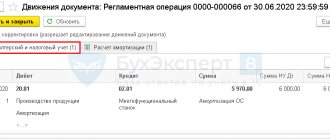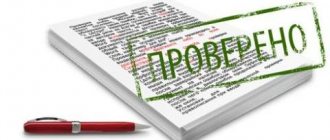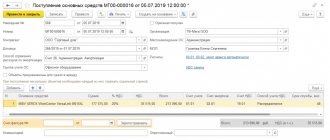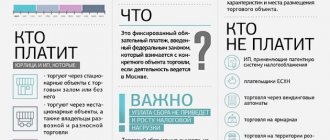Accounting 2
You can study this section only if you have a sample balance sheet in front of you.
It is located in Appendix No. 1. Prepare it for work, if you have not already done so, and place it in front of you. Look at the balance. As you can see, the assets and liabilities of the enterprise are displayed on the balance sheet on different halves: left and right.
This is done to ensure that the organization’s property and debts do not accidentally mix. Property should be in assets, debts - in liabilities. It cannot be otherwise.
On the left half of the balance sheet, the accountant records the value of all assets that the company has.
On the right half of the balance sheet, the accountant records the value of all liabilities that the company has.
However, if an accountant begins to list in the balance sheet all the assets and liabilities of the enterprise, then instead of a two-page report, you will have to send a thick book to the tax office.
For this reason, a long time ago, accountants divided all the assets and liabilities of an enterprise into several groups and called these groups balance sheet items .
Each item was given its own name and a separate line was allocated for it in the balance sheet. All balance sheet items look like special shelves on which the accountant lays out all assets and liabilities.
For example, on the shelf called CASH we will place the money that is stored in the company’s cash register, and that which is in the bank account, and all the other money that the company has. Find this article in the sample.
Please note: the balance sheet may contain items with the same names. For example, in assets we have two lines FINANCIAL INVESTMENTS. Find them in your balance sheet.
This is not a repetition or an error. The fact is that financial investments are divided into two types: those that will return to us no earlier than in a year (non-current assets), and those that will return to us within a year (current assets). You will learn to understand such similar balance sheet items gradually during the learning process. There are no difficulties here. In the meantime, let's continue our acquaintance with the structure of the balance sheet.
You have probably already noticed the leftmost column of the balance sheet, which is called “Explanations”. This column appeared in the balance sheet recently. Why is it needed?
The fact is that in addition to the balance sheet, the company also draws up other reporting documents that are designed to reveal in more detail the content of all balance sheet items. One of them is called “Explanations to the Balance Sheet” . Each explanation in this document is assigned a unique number. The accountant writes this number opposite the balance sheet item that the document “explains.”
Line 5510 of explanations to the balance sheet
This line reflects information about the amount of expenses of the organization in the form of depreciation.
What costs are reflected by element?
"Depreciation"
Expenses for the “Depreciation” element include the amount of depreciation charges for fixed assets and intangible assets used in the normal activities of the organization.
This element includes depreciation, including for leased fixed assets, if depreciation on them is carried out by the lessee, for example:
— for leasing objects accounted for in accordance with the terms of the agreement on the balance sheet of the lessee (clause 2 of article 31 of Federal Law N 164-FZ, clause 9 of the Guidelines for reflecting transactions under a leasing agreement in accounting, paragraph 3 of clause 50 of the Methodological Guidelines on accounting of fixed assets);
- for fixed assets and intangible assets included in the complex of property under an enterprise lease agreement (paragraph 2 of clause 50 of the Guidelines for accounting of fixed assets).
This cost element can also reflect depreciation charges for fixed assets (premises) provided free of charge to public catering organizations serving labor collectives, as well as premises and equipment provided to medical institutions for the organization of medical posts directly on the territory of enterprises (paragraph 3 of clause 18 of the Methodological recommendations (instructions) for planning, accounting and calculating the cost of products of the timber industry complex, clause 3.2.4 Methods of planning, accounting and calculating the cost of housing and communal services, approved by Resolution of the State Construction Committee of Russia dated 02.23.1999 N 9).
FOR MORE on this issue see:
Section “Accounting for production costs and sales expenses (accounts 20 - 29, 44)” of the Guide to Information Security “Correspondence of invoices”
Section “Depreciation” of the Guide to Information Security “Correspondence of Accounts”
What accounting data is used?
to fill in line 5640 “Depreciation”
When filling out line 5640, data on debit turnover for the reporting year according to cost accounting accounts is used (20 “Main production”, 23 “Auxiliary production”, 25 “General production expenses”, 26 “General expenses”, 28 “Defects in production”, 29 “ Servicing production and facilities", 44 "Sales expenses") in correspondence with accounts 02 "Depreciation of fixed assets" and 05 "Depreciation of intangible assets" minus internal turnover.
Losses from defects can either be fully included in the element “Other costs” (clause 25 of the Methodological Recommendations for Accounting for Production Costs and Calculating Costs in Agricultural Organizations), or included in the cost of products (works, services) for the relevant cost elements (material, labor costs, etc.) (Methodological recommendations for the application of the Chart of Accounts of enterprises and organizations of the agro-industrial complex).
In the latter case, when filling out line 5640, you should take into account the debit turnover on account 28 in terms of depreciation.
In general, the indicator in the column “For the previous year” on line 5640 is transferred from Table 6 of the Explanations to the Balance Sheet and the Statement of Financial Results for this previous year.
Example of filling out line 5640 “Depreciation”
EXAMPLE 19.4
In reporting, losses from defects are shown under the “Other” element.
There are no indicators for account 23 regarding accrued depreciation.
Indicators for accounts 20, 25, 26, 29, 44 (analytical accounts for depreciation), cleared from internal turnover, in accounting:
rub.
| Index | For 2013 |
| 1 | 2 |
| depreciation account | 570 904 |
| depreciation account | 105 000 |
| depreciation account | 299 462 |
| depreciation account | 83 926 |
| depreciation account | 20 300 |
Fragment of Table 6 Explanations for 2012:
| Indicator name | Code | For 2012 | For 2011 |
| Depreciation | 5640 | 993 |
Solution
A fragment of Table 6 Explanations in this example will look like this.
| Indicator name | Code | For 2013 | For 2012 |
| Depreciation | 5640 | 1080 | 993 |
Cash accounts in special bank accounts (5500)
Instructions for using the Chart of Accounts for accounting financial and economic activities of business entities
229. Generalization of information on the availability and movement of funds located on the territory of the Republic of Uzbekistan and abroad in letters of credit, check books, other payment documents (except bills), as well as on the movement of funds for targeted financing (receipts) in the part that is subject to separate storage is carried out on the following accounts:
5510 “Letters of credit”;
5520 “Checkbooks”;
5530 “Other special accounts.”
230. Account 5510 “Letters of Credit” records the movement of funds contained in letters of credit. The crediting of funds to letters of credit is reflected in the debit of account 5510 “Letters of credit” and the credit of accounts 5110 “Current account”, 5210 “Currency accounts within the country”, 5220 “Currency accounts abroad”, etc.
Funds accepted for accounting in letters of credit under account 5510 “Letters of credit” are written off as they are used (according to bank statements), to the debit of account 6010 “Accounts payable to suppliers and contractors”. Unused funds in letters of credit after restoration by the bank to the account from which they were transferred are reflected in the credit of account 5510 “Letters of credit” in correspondence with accounts 5110 “Current account”, 5210 “Currency accounts within the country”, 5220 “Currency accounts abroad” and etc.
Analytical accounting for account 5510 “Letters of credit” is maintained for each letter of credit issued by the enterprise.
231. Account 5520 “Checkbooks” takes into account the movement of funds in checkbooks. The deposit of funds when issuing check books is reflected in the debit of account 5520 “Check books” and the credit of accounts 5110 “Current account”, 5210 “Currency accounts within the country”, 5220 “Currency accounts abroad”, 6810 “Short-term bank loans”, etc. As checks issued by the enterprise are paid, the amount is debited from the credit of account 5520 “Check books” in correspondence with the debt and expense accounts. Amounts for checks issued but not paid by the bank (not presented for payment) remain in account 5520 “Checkbooks”, and the balance in account 5520 “Checkbooks” must correspond to the balance on bank statements. Amounts on checks returned to the bank (remaining unused) are reflected in the credit of account 5520 “Check books” in correspondence with account 5110 “Current account” or 5210 “Currency accounts within the country”, 5220 “Currency accounts abroad”.
Control over the movement of funds in checkbooks issued to accountable persons for settlements with creditor enterprises is carried out promptly.
Analytical accounting for account 5520 “Checkbooks” is maintained for each checkbook received.
232. Account 5530 “Other special accounts” takes into account the movement of targeted financing funds (revenues) separately stored in the bank, including funds received for the maintenance of social facilities (kindergarten, nursery, etc.) from parents, other users and from other sources; funds for financing capital investments accumulated and spent at the request of the enterprise from a separate account; subsidies from government agencies, etc.
Separate divisions of the enterprise, which have opened current accounts in banks to carry out current expenses (salaries, certain business expenses, travel expenses, etc.), reflect the movement of these funds in a separate account.
The construction of analytical accounting for account 5530 “Other special accounts” should provide the ability to obtain data on the availability and flow of funds in other special accounts in the territory of the Republic of Uzbekistan and abroad.
233. Correspondence on cash accounts in special bank accounts (5500)
| № | Contents of a business transaction | Account correspondence | |
| Debit | Credit | ||
| Funds credited to letters of credit | |||
| Receipt of the amount of satisfied claims to a special account | |||
| An advance was received from subscribers for shares in the form of a deposit of participants | |||
| Funds were credited to letters of credit from short-term bank loans | |||
| Sales expenses were paid by check | |||
| Refund at the end of the term of unused amount: | |||
| a) letters of credit | 5110-5220 | 5510 | |
| b) check books | 5110-5220 | 5520 | |
| Letters of credit amounts written off when paying debts to suppliers and contractors | |||
| Issuing an advance from a letter of credit | |||
| The insurance debt was repaid using the letter of credit funds | |||
| Write-off of the amount of used checks as payments for the services of other creditors | |||
| Debt to subsidiaries and dependent business companies was repaid from a special account | |||
| Amount paid from a special account for purchased vouchers | |||
| Return of unused checkbook funds to repay short-term bank loans | |||
| Return of unused letter of credit funds to repay long-term bank loans | 6950, 7810 | ||
| Repaid the accrued interest debt | |||
| Payments due to the lessor have been paid | 6910, 6950 | ||
What is accumulated depreciation?
Depreciation is a complex term, but it is important to business. Depreciation is a method of allocating the cost of a business asset (such as machinery, equipment, or vehicles) over the asset's useful life.
Accumulated depreciation is the total decrease in the value of an asset on a business's balance sheet over time.
Business assets on balance sheet
Look at the balance sheet of the business.
On the left side are business assets, things (tangible and intangible) that have value that can be counted.
Scroll down the list of assets until you come to commercial real estate. This is usually shown as "Property, Plant and Equipment (PP&E)." (This asset category does not include land or buildings, which are separate.)
PP&E are items such as cars, vehicles and furniture that have lasting value. The cost of these items cannot be considered a tax deduction for one year, but must be spread over the useful life of the asset. This reduction in spending over several years is a depreciation.
Accumulated depreciation is an account. He took care of my accountant and included in the year end accounting adjustments for your year end balance. While accumulated depreciation is not something you need to worry about on a day-to-day basis, it is important to know how it works in your accounting system.
Depreciation expense and accumulated depreciation
Let's say you have a machine used in your business that costs $10,000. It depreciates over 10 years, so you can take $1,000 off the balance each year.
This depreciation expense is taken along with other expenses on the income statement.
As assets age, accumulated depreciation increases.
Accumulated depreciation on balance sheet
The value of all assets of each type is recorded together on the balance sheet, rather than on an individual asset basis. That car is out there somewhere.
On the balance sheet, the new asset will have no accumulated depreciation. A machine costing $10,000 would appear on the balance sheet (which includes property, plant, and equipment) as $10,000.
But over the years, the car decreases in value (value) by the amount of depreciation expenses. In the second year, the cost of the car will appear on the balance sheet as $9,000.
Here's the tricky part. The car doesn't really decrease in value - until it's sold. Thus, the asset appears in two different accounts: (1) the asset's depreciated cost and (2) accumulated depreciation. The total of these two assets is the original cost (cost) of the asset. The difference between them is the book value of that asset.
The value of assets on the balance sheet is expressed as:
- Asset value
- Less accumulated depreciation
- Equal to the book value of this asset.
Example of accumulated depreciation on balance sheet
On the company's balance sheet as of December 31, 2015:
- Equipment cost $239,000
- Less accumulated depreciation $100,000
- Book Equipment Cost $139,000
Accumulated depreciation and taxes on your business
You won't see "Accumulated Depreciation" on your business tax form, but depreciation itself is included, as stated above, as an annual expense on the business income statement.
Accumulated depreciation and sale of business assets
When you sell an asset, such as the one described above, it takes the asset and the amount of accumulated depreciation for that asset, off the balance sheet. Since the asset's original cost is still shown on the balance sheet, it is easy to see what gain or loss was recognized when the asset was sold.
What are notes to the balance sheet?
This is detailed information about some of the assets and liabilities of an organization as shown on its balance sheet, as well as the income and expenses reported on its Income Statement. The accountant discloses in the explanations the information that he considers important for users, which, in his opinion, is necessary for users to assess the financial position of the organization (clause 6 of PBU 4/99). For example, you can describe in the notes to the balance sheet the fixed assets available to the organization:
- data on the initial cost and accrued depreciation at the beginning and end of the period;
- data on the cost of received and retired fixed assets;
- data on the method of calculating depreciation in accounting.
Who needs a copy of the explanatory note to the balance sheet and why?
An explanatory note to the balance sheet is a detailed substantiation of the data indicated in the financial statements of an organization or entrepreneur.
The explanation is included in the taxpayer’s annual financial statements (Article 14 of the Law “On Accounting” dated 06.12.2011 No. 402-FZ, clause 4 of Order of the Ministry of Finance of Russia dated 02.07.2010 No. 66n). Drawing up an explanatory note to the balance sheet is the responsibility of all companies.




